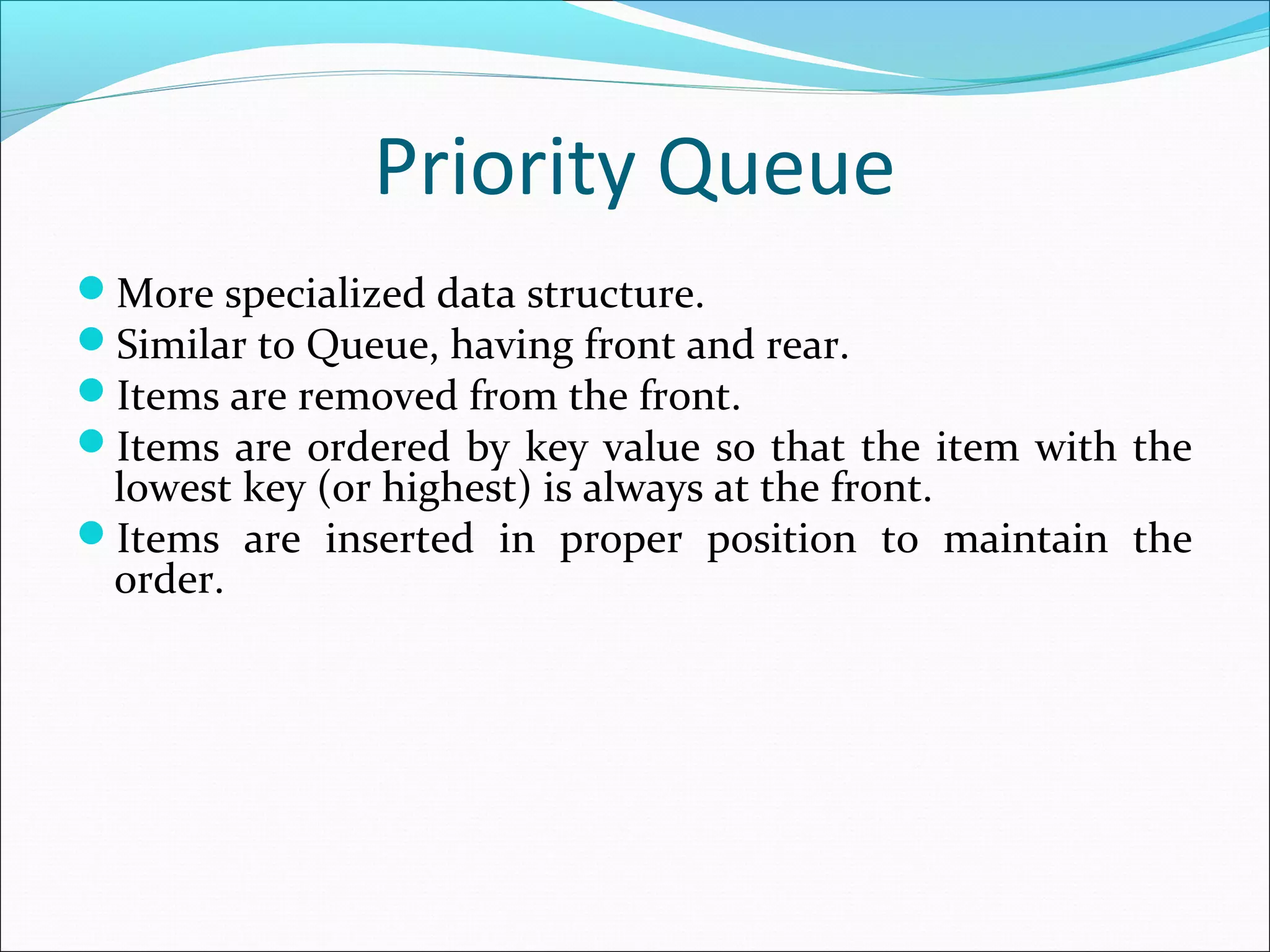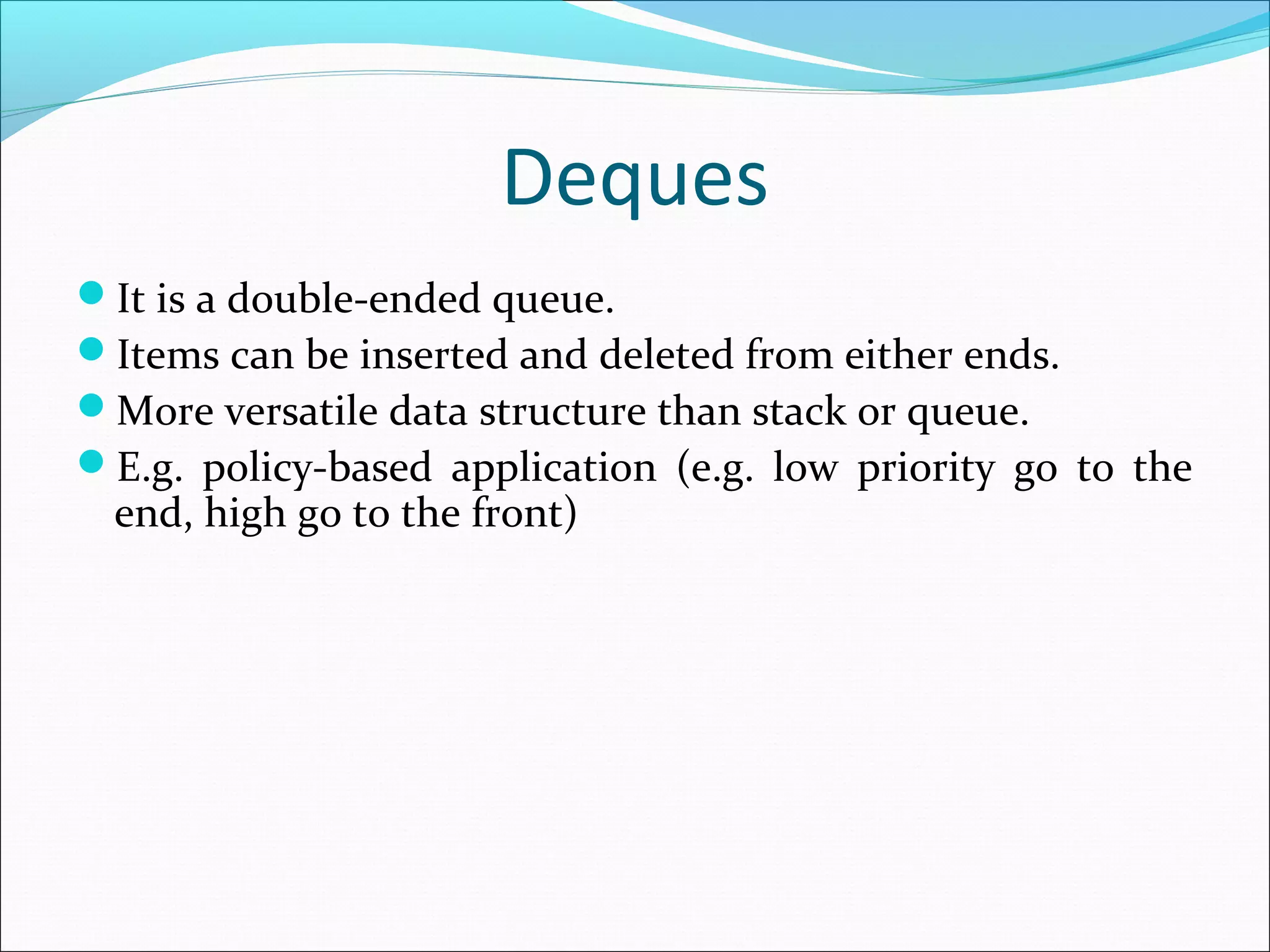This document discusses queues and related data structures. It defines a queue as a first-in, first-out collection where items can be inserted at the rear and deleted from the front. Algorithms for array and linked list implementations of queues are presented for insertion and deletion operations. Priority queues are described as ordered queues where the highest or lowest priority item is always at the front. Deques allow insertion and deletion from both ends and are more versatile than regular queues or stacks.


![Queue
items[MAXQUEUE-
1]
. .
. .
. .
items[2] C
items[1] B
items[0] A Front=0
Rear=2](https://image.slidesharecdn.com/ds8-queuesandrecursion-180827163453/75/Data-Structure-and-Algorithms-Queues-3-2048.jpg)
![Insert an item A
A new item (A) is inserted at the Rear of the queue
items[MAXQUEUE
-1]
. .
. .
items[3]
items[2]
items[1]
items[0] A Front=0,
Rear=0](https://image.slidesharecdn.com/ds8-queuesandrecursion-180827163453/75/Data-Structure-and-Algorithms-Queues-4-2048.jpg)
![Insert an item B
A new item (B) is inserted at the Rear of the queue
items[MAXQUEUE
-1]
. .
. .
items[3]
items[2]
items[1] B Rear=1
items[0] A Front=0](https://image.slidesharecdn.com/ds8-queuesandrecursion-180827163453/75/Data-Structure-and-Algorithms-Queues-5-2048.jpg)
![Insert an item C
A new item (C) is inserted at the Rear of the queue
items[MAXQUEUE
-1]
. .
. .
items[3]
items[2] C Rear=2
items[1] B
items[0] A Front=0](https://image.slidesharecdn.com/ds8-queuesandrecursion-180827163453/75/Data-Structure-and-Algorithms-Queues-6-2048.jpg)
![Insert an item D
A new item (D) is inserted at the Rear of the
queue
items[MAXQUEUE-
1]
. .
. .
items[3] D Rear=3
items[2] C
items[1] B
items[0] A Front=0](https://image.slidesharecdn.com/ds8-queuesandrecursion-180827163453/75/Data-Structure-and-Algorithms-Queues-7-2048.jpg)
![Insert Operation(Array)
QINSERT(QUEUE, N, FRONT, REAR, ITEM)
1. If FRONT = 1 and REAR = N, or FRONT = REAR + 1, then :
write OVERFLOW, and Return.
2. If FRONT = NULL, then:
Set FRONT := 1 and REAR := 1.
Else if REAR = N, then:
Set REAR := 1.
Else :
Set REAR := REAR + 1.
3. Set QUEUE[REAR]:= ITEM.
4. Return.](https://image.slidesharecdn.com/ds8-queuesandrecursion-180827163453/75/Data-Structure-and-Algorithms-Queues-8-2048.jpg)
![Delete A
An item (A) is deleted from the Front of the queue
items[MAXQUEUE-1]
. .
. .
items[3] D Rear=3
items[2] C
items[1] B Front=1
items[0] A](https://image.slidesharecdn.com/ds8-queuesandrecursion-180827163453/75/Data-Structure-and-Algorithms-Queues-9-2048.jpg)
![Delete B
An item (B) is deleted from the Front of the
queue.
items[MAXQUEUE-1]
. .
. .
items[3] D Rear=3
items[2] C Front=2
items[1] B
items[0] A](https://image.slidesharecdn.com/ds8-queuesandrecursion-180827163453/75/Data-Structure-and-Algorithms-Queues-10-2048.jpg)
![Delete C
An item (C) is deleted from the Front of the
queue
items[MAXQUEUE-1]
. .
. .
items[3] D Front=Rear=3
items[2] C
items[1] B
items[0] A](https://image.slidesharecdn.com/ds8-queuesandrecursion-180827163453/75/Data-Structure-and-Algorithms-Queues-11-2048.jpg)
![Delete D
An item (A) is deleted from the Front of the
queue.
items[MAXQUEUE-1]
. .
items[3] D Front=Rear=-1
items[2] C
items[1] B
items[0] A](https://image.slidesharecdn.com/ds8-queuesandrecursion-180827163453/75/Data-Structure-and-Algorithms-Queues-12-2048.jpg)
![Delete Operation(Array)
QDELETE(QUEUE, N, FRONT, REAR, ITEM)
1. If FRONT = NULL then :
write: UNDERFLOW, and Return.
2. Set ITEM := QUEUE[FRONT].
3. If FRONT = REAR,
Set FRONT := NULL and REAR := NULL
Else if FRONT = N, then:
Set FRONT := 1.
Else :
Set FRONT := FRONT + 1.
4. Return.](https://image.slidesharecdn.com/ds8-queuesandrecursion-180827163453/75/Data-Structure-and-Algorithms-Queues-13-2048.jpg)
![Insert Operation(LL)
LINKQ_INSERT(INFO, LINK, FRONT, REAR, AVAIL, ITEM)
1. If AVAIL = NULL, then :
write OVERFLOW, and Exit.
2. Set NEW := AVAIL and AVAIL := LINK[AVAIL]
3. Set INFO[NEW]:= ITEM and LINK[NEW]=NULL
4. If (FRONT = NULL), FRONT := REAR := NEW
Else set LINK[REAR] := NEW and REAR := NEW
5. Exit](https://image.slidesharecdn.com/ds8-queuesandrecursion-180827163453/75/Data-Structure-and-Algorithms-Queues-14-2048.jpg)
![Delete Operation(LL)
LINKQ_DELETE(INFO, LINK, FRONT, REAR, AVAIL,
ITEM)
1. If FRONT = NULL, then :
write UNDERFLOW, and Exit.
2. Set TEMP := FRONT
3. Set ITEM :=INFO[TEMP]
4. FRONT :=LINK[TEMP]
5. LINK[TEMP] = AVAIL and AVAIL = TEMP
6. Exit](https://image.slidesharecdn.com/ds8-queuesandrecursion-180827163453/75/Data-Structure-and-Algorithms-Queues-15-2048.jpg)


